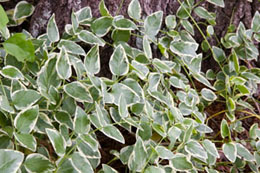Vinca is a genus of herbaceous plants, that are commonly grown in gardens as ground cover. These herbaceous plants are known for their vigorous growth, which explains why they are usually recognized as invasive plants. Learn more about the vinca vine and how to care for it, through this Buzzle article.
 Vinca
Vinca is actually a genus of herbaceous or sub-shrub plants. The plants of this genus belong to the family,
Apocynaceae. The genus
Vinca includes six species of plants, of which the 'vinca minor' and 'vinca major' are more commonly grown in the gardens as groundcover. Both the species are known to be invasive, as they can spread quite rapidly. The vinca major is commonly known as variegated vinca, while vinca minor is commonly called 'periwinkle flower' and 'creeping myrtle'.
Plant Description
As the name suggests, the vinca vine is an evergreen vine with a slender trailing stem, that usually does not exceed a height of 8 to 30 inches. However, it is a fast growing plant that can spread quite rapidly over the ground in a short period of time. This is the reason why it is enlisted as an invasive vine of the Southeastern United States, by the U. S Department of Agriculture. The long and slender stem roots at the nodes at places where it touches the ground. This gives the plant a strong support to spread across a large area.
The plant produces simple flowers in spring and throughout the summer. Its flowers are small and delicate, and are usually violet in color. But occasionally, vinca vines are found to produce white blossoms as well. The plant also produces dry fruits that rupture to release the seeds. The major and the minor vinca can be distinguished by the appearance of their leaves. The minor vinca is found with uniformly green foliage, while the major or variegated vinca is characterized by green foliage, edged with a creamy white border.
Plant Care
The plant grows well in a partially-shaded area. However, it can also be grown in places exposed to full sun. The plant prefers well-drained soil. The ideal time for planting this vine is spring and summer. Stem cuttings are usually used for propagating the plant. The soil should be kept moist to promote its rapid growth. So, water the vine once in a week during the first growing season.
However, the frequency of watering can be reduced during winter and spring. To ensure better growth, the soil should be kept moist to about 1 inch depth. So, check the soil moisture before watering the plant. Once, the plant matures, it requires only minimal care and attention.
Tips for Promoting Blooming
The plant should receive adequate sunlight to produce better blooms. In fact, flower production can get delayed, if the plant is not getting enough sunlight. It has been observed that the plant blooms profusely, when it is exposed to full sun. So, shift the plant to an area that receives more sunlight. But if you have grown vinca on the ground, then ensure that the plant is not shaded by the large trees and other plants of your garden. If branches of other trees and plants are shading your vinca vine, then prune them immediately.
You can also apply a light water soluble or slow-release fertilizer in spring to promote blooming. Usually, this plant can be fertilized once in every two years. If the fertilizer is dry, then be sure to dilute it before applying. Do not use a fertilizer with a very high nitrogen content. In extremely cold regions, the plant may not survive the harsh winter. In such areas, plants grown in containers should be kept indoor in winter till the arrival of spring. It is very important to ensure that the plant survives more than one growing season, so that it can produce better blooms.
Vinca vine is a very hardy plant that can tolerate heat and drought. But it is an invasive plant that needs to be pruned at regular intervals, in order to prevent its overgrowth. So, cut and pull out the end of the vine, and remove all undesired parts, and throw them in your compost bin. If left on the ground, many new plants will emerge from these pieces. If maintained properly, this plant can look really beautiful under the large trees of your garden.






 Vinca is actually a genus of herbaceous or sub-shrub plants. The plants of this genus belong to the family, Apocynaceae. The genus Vinca includes six species of plants, of which the 'vinca minor' and 'vinca major' are more commonly grown in the gardens as groundcover. Both the species are known to be invasive, as they can spread quite rapidly. The vinca major is commonly known as variegated vinca, while vinca minor is commonly called 'periwinkle flower' and 'creeping myrtle'.
Vinca is actually a genus of herbaceous or sub-shrub plants. The plants of this genus belong to the family, Apocynaceae. The genus Vinca includes six species of plants, of which the 'vinca minor' and 'vinca major' are more commonly grown in the gardens as groundcover. Both the species are known to be invasive, as they can spread quite rapidly. The vinca major is commonly known as variegated vinca, while vinca minor is commonly called 'periwinkle flower' and 'creeping myrtle'.